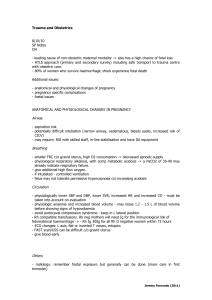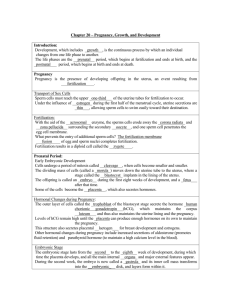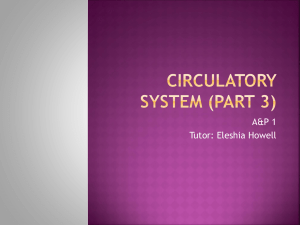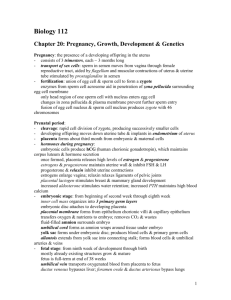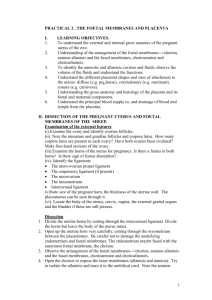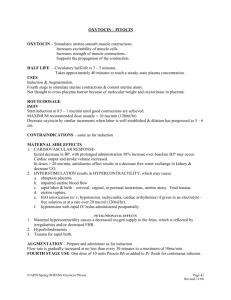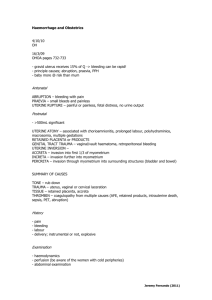Sample section from “The Physiology Viva” by Kerry
advertisement
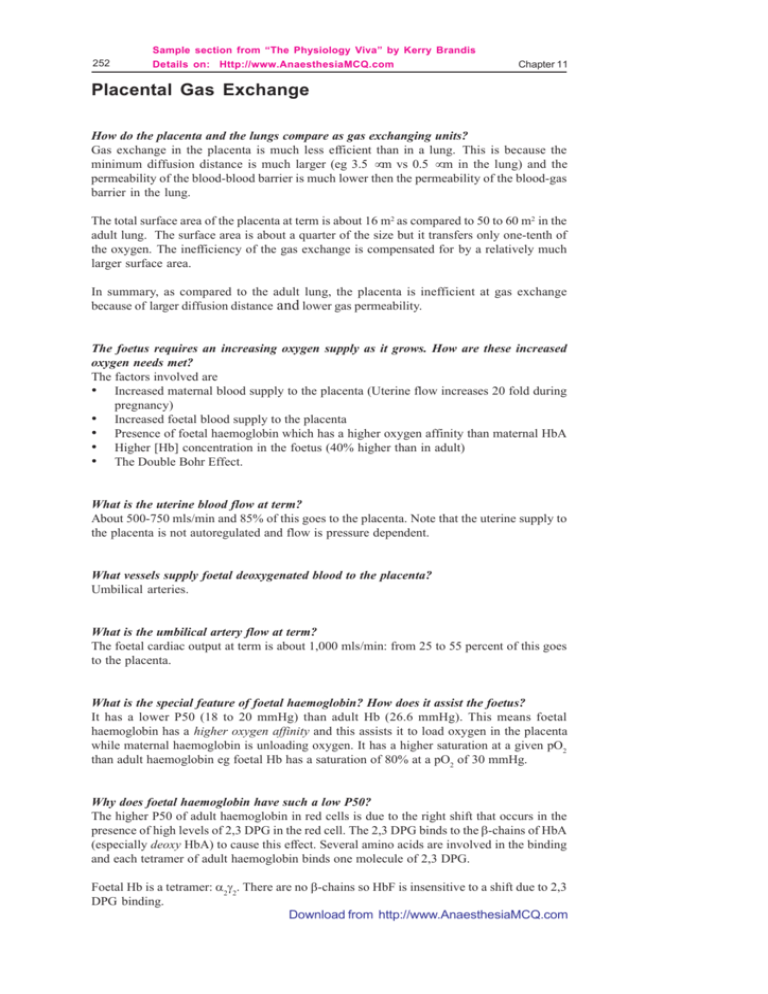
252 Sample section from “The Physiology Viva” by Kerry Brandis Details on: Http://www.AnaesthesiaMCQ.com Chapter 11 Placental Gas Exchange How do the placenta and the lungs compare as gas exchanging units? Gas exchange in the placenta is much less efficient than in a lung. This is because the minimum diffusion distance is much larger (eg 3.5 µm vs 0.5 µm in the lung) and the permeability of the blood-blood barrier is much lower then the permeability of the blood-gas barrier in the lung. The total surface area of the placenta at term is about 16 m2 as compared to 50 to 60 m2 in the adult lung. The surface area is about a quarter of the size but it transfers only one-tenth of the oxygen. The inefficiency of the gas exchange is compensated for by a relatively much larger surface area. In summary, as compared to the adult lung, the placenta is inefficient at gas exchange because of larger diffusion distance and lower gas permeability. The foetus requires an increasing oxygen supply as it grows. How are these increased oxygen needs met? The factors involved are • Increased maternal blood supply to the placenta (Uterine flow increases 20 fold during pregnancy) • Increased foetal blood supply to the placenta • Presence of foetal haemoglobin which has a higher oxygen affinity than maternal HbA • Higher [Hb] concentration in the foetus (40% higher than in adult) • The Double Bohr Effect. What is the uterine blood flow at term? About 500-750 mls/min and 85% of this goes to the placenta. Note that the uterine supply to the placenta is not autoregulated and flow is pressure dependent. What vessels supply foetal deoxygenated blood to the placenta? Umbilical arteries. What is the umbilical artery flow at term? The foetal cardiac output at term is about 1,000 mls/min: from 25 to 55 percent of this goes to the placenta. What is the special feature of foetal haemoglobin? How does it assist the foetus? It has a lower P50 (18 to 20 mmHg) than adult Hb (26.6 mmHg). This means foetal haemoglobin has a higher oxygen affinity and this assists it to load oxygen in the placenta while maternal haemoglobin is unloading oxygen. It has a higher saturation at a given pO2 than adult haemoglobin eg foetal Hb has a saturation of 80% at a pO2 of 30 mmHg. Why does foetal haemoglobin have such a low P50? The higher P50 of adult haemoglobin in red cells is due to the right shift that occurs in the presence of high levels of 2,3 DPG in the red cell. The 2,3 DPG binds to the β-chains of HbA (especially deoxy HbA) to cause this effect. Several amino acids are involved in the binding and each tetramer of adult haemoglobin binds one molecule of 2,3 DPG. Foetal Hb is a tetramer: α2γ2. There are no β-chains so HbF is insensitive to a shift due to 2,3 DPG binding. Download from http://www.AnaesthesiaMCQ.com Sample section from “The Physiology Viva” by Kerry Brandis Maternal, Foetal & Neonatal Physiology Details on: Http://www.AnaesthesiaMCQ.com 253 How long does foetal haemoglobin persist after birth? At birth about 80% of the neonate’s haemoglobin is HbF. This decreases rapidly so that by the age of 6 months less than 5% of the baby’s haemoglobin is HbF. Only very small amounts of HbF are normally present in adults (<1% of total haemoglobin in adults). What is the ‘double Bohr effect’? How does this affect oxygen uptake by the foetus? The term double Bohr effect refers to the situation in the placenta where the Bohr effect is operative in both the maternal and foetal circulations. The increase in pCO2 in the maternal intervillous sinuses assists oxygen unloading. The decrease in pCO2 on the foetal side of the circulation assists oxygen loading. The Bohr effect facilitates the reciprocal exchange of oxygen for carbon dioxide. The double Bohr effect means that the oxygen dissociation curves for maternal HbA and foetal HbF move apart (ie in opposite directions). What are the special factors which assist carbon dioxide transfer across the placenta? The important factors relevant to the placenta are: • Maternal hyperventilation results in a low maternal pCO2 which increases the gradient favouring CO2 transfer • A double Haldane effect occurs and this is unique to the placenta. What is the [Hb] at birth? This is typically high: about 17 to 18 g/dl. In what ways does the haemoglobin change in the first year after birth? The major changes are: • Decrease in [Hb] (physiological anaemia of infancy) • Rapid decrease then elimination of HbF (as discussed above) • Increased production of adult haemoglobin (HbA) to replace HbF. After birth, the arterial pO 2 (and Hb saturation) in the neonate is much higher and erythropoietin levels consequently drop to undetectable levels. Red cell production is markedly decreased and [Hb] falls. The decrease in oxygen delivery is partially compensated by a shift of the haemoglobin oxygen dissociation curve to the right as HbF is replaced by HbA and red cell 2,3 DPG levels rise. Finally, [Hb] levels fall far enough to cause increased levels of erythropoietin and red cell production increases. The physiological anaemia of infancy lasts for about 6 months. Can you tell me what are the pO2, SO 2 and pCO2 values in the uterine vessels and in the umbilical vessels? Typical values are: Maternal circulation • Uterine artery: pO2 100mmHg (SO2 98%); pCO2 32mmHg • Uterine vein: pO2 40mmHg (SO2 75%); pCO2 45mmHg Foetal circulation • Umbilical artery: pO2 18mmHg (SO2 45%); pCO2 55mmHg • Umbilical vein: pO2 28mmHg (SO2 70%); pCO2 40mmHg (see diagram on p255) Download from http://www.AnaesthesiaMCQ.com 254 Sample section from “The Physiology Viva” by Kerry Brandis Details on: Http://www.AnaesthesiaMCQ.com Chapter 11 Can you outline the oxygen balance across the placenta? The points to consider are: • Oxygen is delivered to the placenta from the maternal uterine artery and the foetal umbilical artery • Oxygen is taken away from the placenta in the uterine vein and the umbilical vein. • Placental oxygen consumption is large and is equal to the difference between the oxygen delivered to the placenta and the oxygen taken away from the placenta. Placental oxygen consumption is about 10 mls/kg/min. The placenta is typically one seventh the weight of the foetus so placental oxygen consumption is about 5 mlsO2/min. • Foetal oxygen consumption at term is almost 5 mls O2/kg/min or a total of about 15 to 17mlsO2/min. It is equal to the difference between the oxygen delivery to the foetus in the umbilical vein and the oxygen return to the placenta in the umbilical artery. • The oxygen consumption of the placenta (and myometrium) is equal to the total oxygen delivered to the placenta and uterus less the total oxygen taken away from the placenta and uterus. Oxygen flow is equal to oxygen content multiplied by the blood flow. In any vessel, oxygen content is equal to ([Hb] x SO2 x 1.34). The calculations to determine oxygen balance in the placenta require values for 12 parameters. These are listed below with some typical values: Mother 1. Uterine blood flow 2. Maternal [Hb] 3. SO2 in the uterine artery 4. SO2 in the uterine vein 5. pO2 in uterine artery 6. pO2 in uterine vein 600 mls/min 120 g/l (low due ‘physiological anaemia’) 98% 75% 100 mmHg 40 mmHg Foetus 7. Umbilical blood flow 8. Foetal [Hb] 9. SO2 in umbilical artery 10. SO2 in umbilical vein 11. pO2 in umbilical artery 12. pO2 in umbilical vein 300 mls/min 170 g/l 45% (despite low pO2 due high O2 affinity) 70% (despite low pO2 due high affinity) 18 mmHg 28 mmHg Oxygen supply to the placenta (from mother and foetus) must be equal to the oxygen flow away from the placenta plus the oxygen consumption of the placenta and myometrium. Also, the results of our calculations can be checked to see if they agree with our predictions for foetal oxygen consumption and placental oxygen consumption. Using the typical values above: Oxygen delivery to the placenta (and uterus) = Oxygen delivery in uterine artery + Oxygen delivery in umbilical artery = [(120 x 1.34 x 0.98) + (0.03 x 100)] x 0.6 + [(170 x 1.34 x 0.45) + (0.03 x 18)] x 0.3 = (96.4 + 30.9) mlsO2/min = 127.3 mls O2/min Oxygen carried away from the placenta (and uterus) = Oxygen flow in uterine vein + Oxygen flow in umbilical vein = [(120 x 1.34 x 0.75) + (0.03 x 40)] x 0.6 + [(170 x 1.34 x 0.70) + (0.03 x 28)] x 0.3 = (73.1 + 48.1) mlsO2/min = 121.2 mlsO2/min Foetal oxygen consumption = Oxygen flow in umbilical vein - oxygen flow in umbilical artery Download from http://www.AnaesthesiaMCQ.com Sample section from “The Physiology Viva” by Kerry Brandis Maternal, Foetal & Neonatal Physiology Details on: Http://www.AnaesthesiaMCQ.com 255 = 48.1 - 30.9 = 17.2 mls/min Placental & myometrial oxygen consumption = Oxygen delivery to placenta - Oxygen carried away from placenta = 127.3 - 121.2 = 6.1 mls/min Note that the combination of a low maternal [Hb] and the high foetal [Hb] requires either that the uterine artery flow is significantly higher than umbilical artery flow or that the oxygen extraction ratio in the placenta is high (or some combination of these two circumstances). (A complete or a consistent set of values for the above calculations is difficult to find in the literature. Human data is difficult to obtain and values derived from animal work are sometimes quoted.) Fig 11.2 Placental Oxygen Balance Uterine artery pO2 SO2 CO2 100mmHg 98% 16.1 mlsO2/dl Uterine vein Uterine Flow = 600 mls/min Maternal [Hb] = 120 g/l p50 of HbA: 26.6 mmHg pO2 SO2 CO2 40mmHg 75% 12.2 mlsO2/dl Maternal sinuses > Surface Area 12 to 16 m2 Mean pO2 gradient = 30mmHg Diffusion distance = 3.5 µm Foetal capillaries Umbilical artery pO2 SO2 CO2 18mmHg 45% 10.3 mlsO2/dl > Umbilical Flow = 300 mls/min Foetal [Hb] = 170 g/l p50 of HbF: 20 mmHg Umbilical vein pO2 SO2 CO2 28mmHg 70% 16.0 mlsO2/dl Oxygen transfer is decreased: • By low pressure in uterine artery (eg aortocaval compression, maternal hypotension) • During uterine contractions Can you draw the oxygen dissociation curves for maternal and foetal haemoglobin indicating values in the placenta? (using oxygen content on the y-axis) This involves drawing four dissociation curves because the curves for maternal HbA and foetal HbF are different and each requires a second curve to demonstrate the change in affinity due to the Bohr effect (ie the ‘double Bohr’ effect) The use of oxygen content on the y-axis allows clear demonstration of the differences in content due to the low [Hb] of the mother and the high [Hb] of the foetus. The position of the maternal ODC tends to be similar to that normal adult HbA. The low maternal pCO2 tends to shift the curve to the left but the effect of this is minimised because maternal arterial pH usually returns to the normal range. An increased maternal red cell 2,3 DPG also shifts the curve rightward. Download from http://www.AnaesthesiaMCQ.com 256 Sample section from “The Physiology Viva” by Kerry Brandis Details on: Http://www.AnaesthesiaMCQ.com Chapter 11 Fig 11.3 Oxygen Dissociation Curves for Mother and Foetus Umbilical Vein Umbilical Artery Uterine Artery Oxygen Content Uterine Vein (mlsO 2/dl) pO2 (mmHg) Both maternal (HbA) and foetal (HbF) oxygen dissociation curves undergo a change in position due to the Bohr effect. This is known as the ‘double Bohr effect ’ and is one of the factors that facilitates oxygen transfer from maternal blood to foetal blood. (The curves above are drawn with a little artistic licence so actual values are not indicated on the x and y axes. The actual oxygen contents in each vessel in any individual person depends on the [Hb] and the oxygen saturations.) Download from http://www.AnaesthesiaMCQ.com
